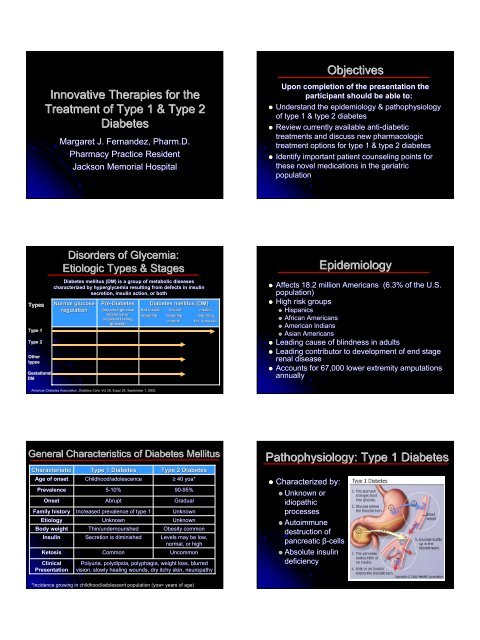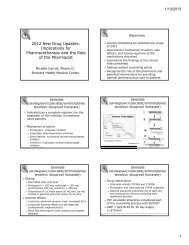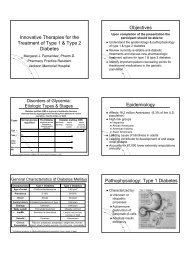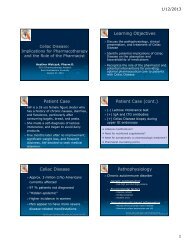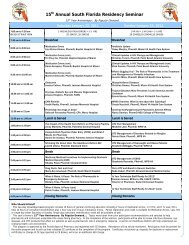Type 1 Diabetes - Dcpa.us
Type 1 Diabetes - Dcpa.us
Type 1 Diabetes - Dcpa.us
Create successful ePaper yourself
Turn your PDF publications into a flip-book with our unique Google optimized e-Paper software.
Innovative Therapies for theTreatment of <strong>Type</strong> 1 & <strong>Type</strong> 2<strong>Diabetes</strong>Margaret J. Fernandez, Pharm.D.Pharmacy Practice ResidentJackson Memorial HospitalObjectivesUpon completion of the presentation theparticipant should be able to:• Understand the epidemiology & pathophysiologyof type 1 & type 2 diabetes• Review currently available anti-diabetictreatments and disc<strong>us</strong>s new pharmacologictreatment options for type 1 & type 2 diabetes• Identify important patient counseling points forthese novel medications in the geriatricpopulation<strong>Type</strong>s<strong>Type</strong> 1<strong>Type</strong> 2OthertypesGestationalDMDisorders of Glycemia:Etiologic <strong>Type</strong>s & Stages<strong>Diabetes</strong> mellit<strong>us</strong> (DM) is a group of metabolic diseasescharacterized by hyperglycemia resulting from defects in insulinsecretion, insulin action, or bothNormal glucoseregulationPre-<strong>Diabetes</strong>(Impaired glucosetolerance orimpaired fastingglucose)<strong>Diabetes</strong> mellit<strong>us</strong> (DM)Not insulin Insulin Insulinrequiring requiring requiringcontrolfor survivalEpidemiology• Affects 18.2 million Americans (6.3% of the U.S.population)• High risk groups• Hispanics• African Americans• American Indians• Asian Americans• Leading ca<strong>us</strong>e of blindness in adults• Leading contributor to development of end stagerenal disease• Accounts for 67,000 lower extremity amputationsannuallyAmerican <strong>Diabetes</strong> Association. <strong>Diabetes</strong> Care. Vol 28, Suppl 28. September 1, 2005.General Characteristics of <strong>Diabetes</strong> Mellit<strong>us</strong>CharacteristicAge of onsetPrevalenceOnsetFamily historyEtiologyBody weightInsulinKetosisClinicalPresentation<strong>Type</strong> 1 <strong>Diabetes</strong>Childhood/adolescence5-10%AbruptIncreased prevalence of type 1UnknownThin/undernourishedSecretion is diminishedCommon<strong>Type</strong> 2 <strong>Diabetes</strong>≥ 40 yoa*90-95%95%GradualUnknownUnknownObesity commonLevels may be low,normal, or highUncommonPolyuria, polydipsia, polyphagia, weight loss, blurredvision, slowly healing wounds, dry itchy skin, neuropathyPathophysiology: <strong>Type</strong> 1 <strong>Diabetes</strong>• Characterized by:• Unknown oridiopathicprocesses• Autoimmunedestruction ofpancreatic β-cells• Absolute insulindeficiency*Incidence growing in childhood/adolescent population (yoa= years of age)
Patient Education• How should I <strong>us</strong>e Symlin?• Symlin and insulin should not be mixed and m<strong>us</strong>t beadministered separately• Different syringes for Symlin & insulin should be <strong>us</strong>ed• Symlin is injected under the skin of the stomach area orthigh• Symlin should be injected at a site >2 inches away fromwhere insulin was injected• What are the possible side effects of Symlin?• Hypoglycemia*• Na<strong>us</strong>ea• Decreased appetite, vomiting, stomach pain, dizziness,indigestion*Boxed warning: insulin-induced severe hypoglycemia in type 1 diabetesSymlin [package insert]. San Diego, CA; Amylin Pharmaceuticals, Inc; 2005.15304560120Patient EducationSymlin Dose in mcgSymlin Dosing ChartThis amount should be drawn in U-U100 Insulin Syringe (units)2 ½57 ½1020This table should be <strong>us</strong>ed to match the patient’s Symlin dose to insulin syringe units•When should I not <strong>us</strong>e Symlin?• Blood sugar too low• Should not be <strong>us</strong>ed if a meal is skipped• Sick and cannot eat a <strong>us</strong>ual meal•How should I store Symlin?• Unopened vials should be refrigerated• Opened vials can be refrigerated or kept at room temperature for up to 28 daysSymlin [package insert]. San Diego, CA; Amylin Pharmaceuticals, Inc; 2005.Insulin detemir (Levemir®)• Long-acting insulin analogue <strong>us</strong>ed as basal insulin, incombination with meal-related short- or rapid-actingactinginsulin in type 1 or type 2 diabetes• FDA approval September 2005• Advantages:• Time action profile is less variable and more predictable thanthat for NPH insulin• Lower risk of nocturnal hypoglycemia• No associated weight gain• Disadvantages:• Cannot be mixed with other insulin, necessitating additionalinjections• Cost comparable to insulin glargine: $75-$225$225Drug classMechanism ofactionFormulationDosage/RouteTmax/Duration ofactionHalf-lifelifeMetabolismSpecialPopulationsPharmacologyLong-acting human insulin analogueFacilitated uptake of glucose following binding of insulinto receptors on m<strong>us</strong>cle and fat cellsSimultaneo<strong>us</strong> inhibition of glucose output from the liver100 U/mL solution for injection in a pre-filled penSubcutaneo<strong>us</strong>6 and 8 hours after administration24 hours5 and 7 hours depending on the doseDegradation of insulin detemir is similar to that ofhuman insulin; all metabolites formed are inactiveNo clinically relevant differences in the PK of insulindetemir between elderly & young subjectsLevemir [package insert]. Bagsvaerd, Denmark. Novo Nordisk.2005.Levemir [package insert]. Bagsvaerd, Denmark. Novo Nordisk.2005.ReferenceVagueet al.Home etal.Efficacy/Safety Clinical TrialsN,Diagnosis448,type 1408,type 1TreatmentInsulin detemir + aspartNPH + aspartInsulin detemir(morning & bedtime)+aspartBlood GlucoseHbA1c 7.60±0.09%HbA1c 7.64±0.10%HbA1c 7.78±0.07% FPG 160.92±6.666.66mg/dLWeightChange a-0.2 kg+0.7 kg+0.24 kgHypoglycemicEvents7522 (all severities) a923 (nocturnal) a4820 (all severities) a689 (nocturnal) a83% (anytime) a ,34% (nocturnal) aInsulin detemir vs. NPH in <strong>Type</strong> 1DM: Randomized Clinical TrialInsulin detemir (12 hapart)+ aspartNPH (morning &bedtime) + aspartHbA1c 7.75±0.07% FPG 175.5±6.66 mg/dLHbA1c 7.94±0.07% FPG 202.32±6.84 mg/dL+0.22 kg+0.86 kg84% (anytime) a ,44% (nocturnal) a84% (anytime) a ,50% (nocturnal) aRaslovaet al.395,type 2Insulin determir +aspartHbA1c 7.46% b+0.51kg65% (nocturnal) bNPH +InsulinHbA1c 7.52% b+1.13 kg70% (nocturnal) ba Statistically significant compared with control groupb Not statistically significantAnn Pharmacother. 39:502-7. 2005Home P, Bartley P, R<strong>us</strong>sell-Jones D. et.al. Insulin detemir offers improved glycemic control compared with NPH insulin inpeople with type 1 diabetes. <strong>Diabetes</strong> Care 27:1081-1087, 2004.
Patient Education• How should I <strong>us</strong>e insulin levemir?• Insulin detemir is for injection under the skin and choosing differentferentinjection sites each time is advised• How should I store insulin detemir?• Un<strong>us</strong>ed insulin levemir should be refrigerated• Insulin levemir that is being <strong>us</strong>ed can be kept at room temperature re forup to 6 weeks• What are the possible side effects?• Hypoglycemia• Injection site reactions• Lipodystrophy• Allergic reactions• Urticaria, rash• Temporary worsening of diabetic retinopathyLevemir [package insert]. Bagsvaerd, Denmark. Novo Nordisk.2005.New Agents Awaiting FDAApproval…• Inhaled insulin• Alternative for patients with type 2 diabetes who do not achieveglycemic control with oral agent therapy alone• Pooled data from two Phase III studies involving 304 adults withtype II diabetes• Maintained glycemic control for two years• Experienced no clinically important effects on pulmonary functioncompared to patients treated with oral agents alone• Vidagliptin• Oral dipeptidyl peptidase-IV inhibitor for type 2 diabetes• Randomized, double-blind, blind, placebo-controlled controlled trial• Increased levels of glucagon-like like peptide-1 1 (GLP-1)• Increased insulin secretory rate• Decreased mean prandial glucose and glucagonRosenstock J, Zinman B, Murphy, LJ, et.al. Inhaled insulin improves glycemic control when substituted for or added to oral combination therapy intype 2 diabetes. Ann Intern Med. 143:549-558, 2005.Mari A, Sallas Y, He L, et.al. Vidagliptin, a dipeptidyl peptidase-IV inhibitor, improves model-associated ß-cell function in patients with type 2 diabetes.J Clin Endocrinol Metab. 90:4888-4894, 2005.Concl<strong>us</strong>ion• Prevalence of diabetes is growing at epidemicproportions• Current treatment options provide similarglucose lowering and efficacy• Despite the availability of several medication classesoptimal glycemic control is not achieved in themajority of patients• New classes of medications can offer furtherimprovements in glycemic control and additionalclinical benefits in the management of patientswith type 1 and type 2 diabetes


